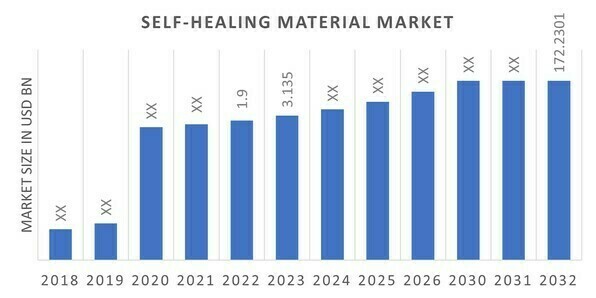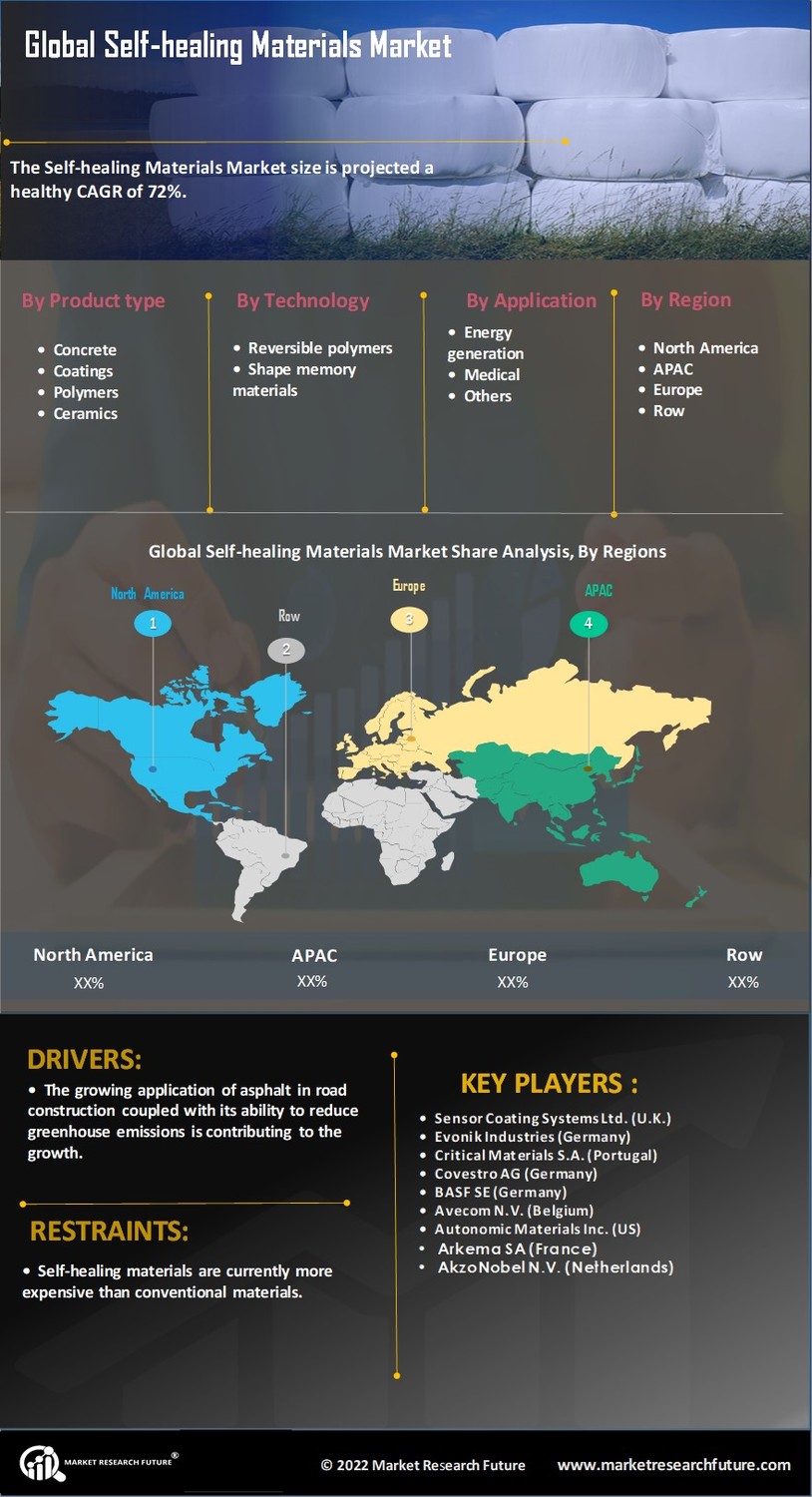Global Self-Healing Material Market Overview
Self-Healing Material Market Size was valued at USD 3.14 billion in 2023. The Self-Healing Material industry is projected to grow from USD 5.17 billion in 2024 to USD 172.23 billion by 2032, exhibiting a compound annual growth rate (CAGR) of 54.99% during the forecast period (2024 - 2032). Increased are the key market drivers enhancing the market growth.

Source: Secondary Research, Primary Research, MRFR Database and Analyst Review
Self-Healing Material Market Trends
-
Growing construction industries are driving the market growth.
The growth in the construction industry is expected to offer significant opportunities to the self-healing materials market. Self-healing materials are materials that can repair damage to themselves without the need for external intervention. These materials can potentially revolutionize the construction industry by reducing maintenance costs and increasing the lifespan of buildings and infrastructure. The construction industry is one of the largest consumers of materials, and the demand for construction materials is expected to grow as the world's population increases. With the rise of urbanization and infrastructure development, there is a growing need for high-quality, durable construction materials that can withstand the stresses and strains of everyday use. These materials can be repaired when damaged, reducing the need for repairs and replacement and saving time and money. Therefore, such factors related to Self-healing Materials have enhanced the market CAGR in recent years.
Additionally, the wind power industry is a rapidly growing composite application industry, where reinforcing fibers are used in light rotor blade manufacturing. A fundamental feature of the design of wind blades is choosing suitable materials, which can affect many parameters such as weight, load & fatigue behavior, physical properties, etc. Materials such as bamboo, steel, and aluminum were used to manufacture wind blades many years earlier. In a cost-driven market, the wind industry relies on bottom-line prices and how to do more but pay less. Composite components allow high strength at a low weight, meaning that more extended and more powerful rotor blades can be generated cost-effectively for more giant wind turbines. The primary construction material used to manufacture wind turbine blades is glass. Wind turbines are primarily made of steel (71-79 percent of total turbine mass), resin or plastic (11-16 percent), iron or cast iron (5-17 percent), copper (1 percent), and aluminum (0-2 percent), as per the study conducted by National Renewable Energy Laboratory. Composites, such as FRP, are reinforcement materials in many wind applications. Their elevated strength and rigidity characteristics make them ideal turbine components combined with their low weight and design versatility. These materials have proved to be one of the most flexible composites. Ultimately, the ability to mold this fiber into complicated forms enables the blade maker to provide various alternatives to any particular concern. Thus, driving the Self-Healing Material market revenue.
Self-Healing Material Market Segment Insights
Self-Healing Material Product Type Insights
The Self-Healing Material market segmentation, based on product type, includes concrete, coatings, polymers, and ceramics. The polymers segment dominated the market; increasing demand attributed to the increasing adoption of polymers like polyurethane, cross-linked polymers, trimers, and multifunctional polymers owing to exceptional properties like thermal stability, durability, resistance to abrasion, thermodynamical stability, and abrasion resistance shall drive the growth.
Self-Healing Material Applications Insights
Based on applications, the Self-Healing Material market segmentation includes energy generation, medical, energy generation, and medical others. The generation segment dominated the market because self-healing materials can be used to improve the efficiency and reliability of energy generation systems. And they can repair damage to components, such as solar cells and wind turbines, which can lead to losses in efficiency.
Figure1: Global Self-Healing Material Market, by Applications, 2022 & 2032 (USD billion)

Source: Secondary Research, Primary Research, MRFR Database and Analyst Review
Self-Healing Material Regional Insights
By Region, the study provides market insights into North America, Europe, Asia-Pacific and the Rest of the World. The North American Self-Healing Material market area will dominate this market, owing to industries' adoption of green technologies and environment-friendly construction materials are anticipated to impact the market growth in this Region positively.
Further, the major countries studied in the market report are The U.S., Canada, German, France, the UK, Italy, Spain, China, Japan, India, Australia, South Korea, and Brazil.
Figure2: SELF-HEALING MATERIAL MARKET SHARE BY REGION 2022 (%)

Source: Secondary Research, Primary Research, MRFR Database and Analyst Review
Europe's Self-Healing Material market accounts for the second-largest market share due to the increasing use of self-healing materials attributed to incomparable properties like durability, thermal stability, abrasion resistance, stiffness, strength, and others shall foster market growth. Further, the German Self-Healing Material market held the largest market share, and the UK Self-Healing Material market was the fastest-growing market in the European Region.
The Asia-Pacific Self-Healing Material Market is expected to grow fastest from 2023 to 2032. This is due to increasing R&D on self-healing batteries and devices, and corrosion-resistant materials for marine and oil & gas application areas in the Region is anticipated to fuel the market growth. Moreover, China’s Self-Healing Material market held the largest market share, and the Indian Self-Healing Material market was the fastest-growing market in the Asia-Pacific region.
Self-Healing Material Key Market Players& Competitive Insights
Leading market players are investing heavily in research and development to expand their product lines, which will help the Self-Healing Material market grow even more. Market participants are also undertaking various strategic activities to expand their footprint, with important market developments including new product launches, contractual agreements, mergers and acquisitions, higher investments, and collaboration with other organizations. To expand and survive in a more competitive and rising market climate, the Self-Healing Material industry must offer cost-effective items.
Manufacturing locally to minimize operational costs is one of the key business tactics manufacturers use in the Self-Healing Material industry to benefit clients and increase the market sector. In recent years, the Self-Healing Material industry has offered some of the most significant advantages to medicine. Major players in the Self-Healing Material market, including AkzoNobel N.V., Arkema SA, Autonomic Materials Inc., Avecom N.V., BASF SE, CompPair Technologies Ltd., Critical Materials S.A., E.I. Du Pont De Nemours and Company, Evonik Industries, Sensor Coating Systems Ltd., and others, are attempting to increase market demand by investing in research and development operations.
BASF SE, an initialism, And Portmanteau for its original name Badische Anilin- und Soda-Fabrik, is a European multinational company and the largest chemical producer in the world. Its headquarters are in Ludwigshafen, Germany.BASF SE acquired Chemetall GmbH, a producer of specialty chemicals and surface treatment products.
Evonik Industries AG is a stock-listed German specialty Chemicals Company headquartered in Essen, North Rhine-Westphalia, Germany. It is the second-largest chemicals company in Germany and one of the largest specialty chemicals companies in the world. Evonik Industries acquired the Specialty & Coating Additives business of Air Products (U.S.), strengthening its leading position in the high-margin specialty & coating adhesives market.
Self Healing Material Market Developement
September 2024
Research has been conducted on sports equipment using self-healing materials such as pole vault poles. Additional development is being made on self-healing composites alongside the coatings that have been patented, which would make pole vaulting materials safer.
February 2022
A Massachusetts Institute of Technology team has turned to biology to create self-healing circuits. The new self-healing system is based on biological hydrogels, allowing the circuits to recover and function fully. According to the researchers, they brought forth a complete opinion on how healing materials indeed could operate rather than a theoretical understanding.
August 2022
MIT has significantly improved upon the self-healing device by making it capable of repairing extensive damage. Previously, the devices could self-repair themselves but only in a small range, so the machines were still required to be taken care of. In the self-healing machines developed by MIT, the hydrogels are placed in 3D microchip structures, allowing the machines to operate without needing any external action.
October 2022
Innovation by North Carolina State University: North Carolina State University researchers have invented a new self-healing composite material that can be repaired without cambering. This Contour Expansion Unit Availability targets bespoke exposures, including wind turbine blades and aircraft wing structures, enhancing high-stress components' life span and endurance.
September 2021
The Air Force Academy, in conjunction with the Wright-Patterson Air Force Base, has developed a new approach for designing materials capable of self-repairing. The new polymer has been manufactured to imitate biological processes. This would aid in increasing the life expectancy of a device because the device would be able to heal on its own without the need for external influence or action.
December 2022
Advancements in Multi-Self-Healing Polymers by Riken Institute: In a recent exposure, scientists elucidated their research on self-healing polymer synthesis with readily available commercial compounds for the very first time.This is an innovative polymer comprising building blocks that can self-repair, thus working the path for cost- and scale-effective materials that translate to a significant leap in the advancement of polymer technology.
Key Companies in the Self-Healing Material market include
-
AkzoNobel N.V.
- Arkema SA
- Autonomic Materials Inc.
- Avecom N.V.
- BASF SE
- CompPair Technologies Ltd.
- Critical Materials S.A.
- Du Pont De Nemours and Company
- Evonik Industries
Self-Healing Material Market Segmentation
Self-Healing Material Product Type Outlook
- Concrete
- Coatings
- Polymers
- Ceramics
Self-Healing Material Applications Outlook
- Energy generation
- Medical
- Others
Self-Healing Material Regional Outlook
- North America
- Europe
- Germany
- France
- UK
- Italy
- Spain
- Rest of Europe
- Asia-Pacific
- China
- Japan
- India
- Australia
- South Korea
- Australia
- Rest of Asia-Pacific
- Rest of the World
- Middle East
- Africa
- Latin America
| Report Attribute/Metric |
Details |
| Market Size 2023 |
USD 3.14 billion |
| Market Size 2024 |
USD 5.17 billion |
| Market Size 2032 |
USD 172.23 billion |
| Compound Annual Growth Rate (CAGR) |
54.99%(2024-2032) |
| Base Year |
2023 |
| Market Forecast Period |
2024-2032 |
| Historical Data |
2018- 2022 |
| Market Forecast Units |
Value (USD Billion) |
| Report Coverage |
Revenue Forecast, Market Competitive Landscape, Growth Factors, and Trends |
| Segments Covered |
Product Type, Applications, and Region |
| Geographies Covered |
North America, Europe, AsiaPacific, and the Rest of the World |
| Countries Covered |
The U.S., Canada, German, France, UK, Italy, Spain, China, Japan, India, Australia, South Korea, and Brazil |
| Key Companies Profiled |
AkzoNobel N.V., Arkema SA, Autonomic Materials Inc., Avecom N.V., BASF SE, CompPair Technologies Ltd., Critical Materials S.A., E.I. Du Pont De Nemours and Company, Evonik Industries, Sensor Coating Systems Ltd |
| Key Market Opportunities |
The growing application in medical devices and drug delivery systems |
| Key Market Dynamics |
The growing application of asphalt in road construction and its ability to reduce greenhouse emissions contribute to the growth. |
Self-healing materials Market Highlights:
Frequently Asked Questions (FAQ) :
The Self-Healing Material market size was valued at USD 3.14 Billion in 2023.
North America had the largest share of the Self-Healing Material market market
North America had the largest share of the Self-Healing Material market market
The key players in the market areAkzoNobel N.V., Arkema SA, Autonomic Materials Inc., Avecom N.V., BASF SE, CompPair Technologies Ltd., Critical Materials S.A., E.I. Du Pont De Nemours and Company, Evonik Industries, Sensor Coating Systems Ltd.
The polymers category dominated the market in 2023.
Energy generation had the largest share of the Self-Healing Material market


















